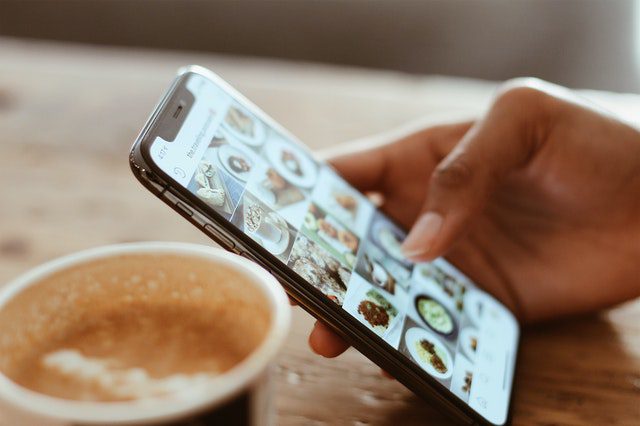Whether you’re a new ecommerce business or well-established in your industry, social media is an invaluable tool to sell your products. Knowing how to link your social media accounts to your existing website can help you make the most of those platforms.
Luckily, many ecommerce platforms have made it easy to add the profiles you want and use them to enhance your business. There are so many things you can do, such as promote products, gain new followers, or even sell directly from the social media channels of your choosing.
In this guide, we’ll walk you through all the steps you need to start integrating social channels into your business on the two main ecommerce platforms: BigCommerce and Shopify.
BigCommerce
BigCommerce gives you the abilities both to link your social channels to your storefront and to set up selling through Facebook and Instagram. Linking your social media channels to your storefront gives customers a direct link to you on every platform, which makes it easy for them to find and follow you. It also encourages them to share your posts on their pages so their friends can see your products as well.
Selling directly through Facebook or Instagram is a great way to make it easy for customers to find products they want and buy them all in the same place. Customers are more likely to buy when there are fewer steps in the process.
Facebook is the most important platform for marketing and ecommerce social media, with 1.93 billion daily users and over 90 million small businesses. Instagram is the fourth most popular platform, behind YouTube and WhatsApp, with 500 million daily active users. 81% of Instagram users search for products and interact with brand accounts. Being able to link these social channels through BigCommerce gives you more freedom and ways to grow your business.
Knowing your goals will help you decide which route is right for you, or if you want to do both!
To Link Your Social Media Channels on Your Storefront:
Step 1: Go to your storefront and click “Social Media Links” in the control panel.
Step 2: Click and drag the icon you want to show up on your page under the “Live on Your Storefront” section. Note: You may only use 6 icons at one time.
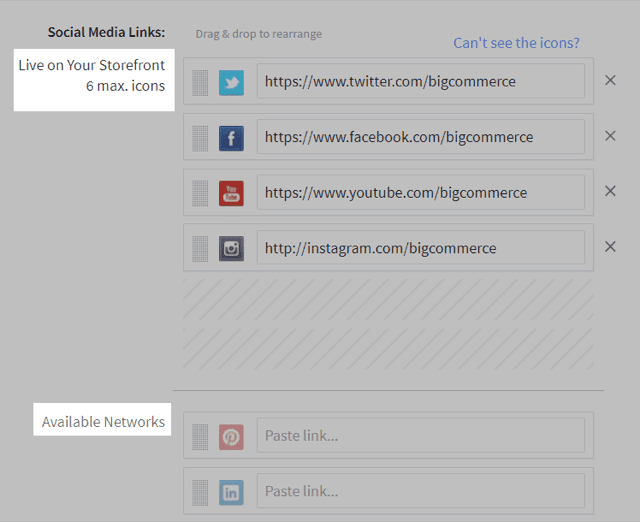
Source: BigCommerce
Step 3: Copy your social media link and paste it into the blank field next to the icon.
You can change the order of the icons by clicking and dragging them up or down on the list, or remove them altogether by clicking the “X” on the far right.
Supported Social Media Channels
- YouTube
- Tumblr
- RSS Feed
Customization
Another great BigCommerce feature when linking social media channels to your storefront is the ability to customize them to match your branding. In the Page Builder, you can change the colors and location of the icons to fit wherever you want them on the page. Customizing is a great way to keep the appearance of your site cohesive and on brand.
To Link Your Facebook or Instagram and Start Selling Directly:
Step 1: From your Facebook page, add a store tab.
Step 2: Change the layout to match your BigCommerce storefront.
Step 3: Add your products.
Step 4: Link the shopping cart to the new store.
Selling directly through Facebook or Instagram gives you and your customers a completely integrated experience. People can search for, buy, and review products from your store all in one place. It’s the perfect way to reach thousands of new customers while also promoting products for current followers.
Shopify
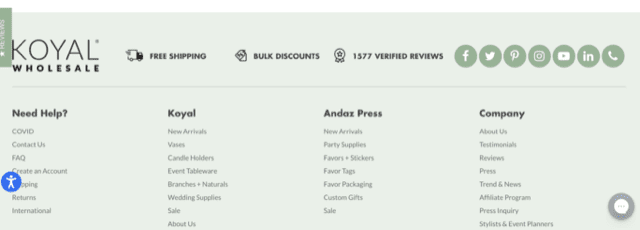
Source: Koyal
Shopify is more focused on helping businesses sell directly from their social media channels. Not only does Shopify allow selling on Facebook and Instagram, like BigCommerce, but it also gives you the option to sell on TikTok. Having an extra platform to use for ecommerce can be a big advantage when trying to reach new customers and get your products out there.
Follow the steps below to start selling on your social channels almost immediately:
Facebook and Instagram
Step 1: Make sure to create a Facebook business page.
Step 2: Add products to the Facebook catalog.
Step 3: From Shopify, click Facebook Sales Channel Overview.
Step 4: In the Instagram shopping section, choose Set up.
Step 5: Connect your Facebook account to the Facebook sales channel.
Step 6: Accept terms and conditions and request approval.
Facebook will review your products within 24-48 hours. After you’re approved, you’re ready to start selling on both Facebook and Instagram!
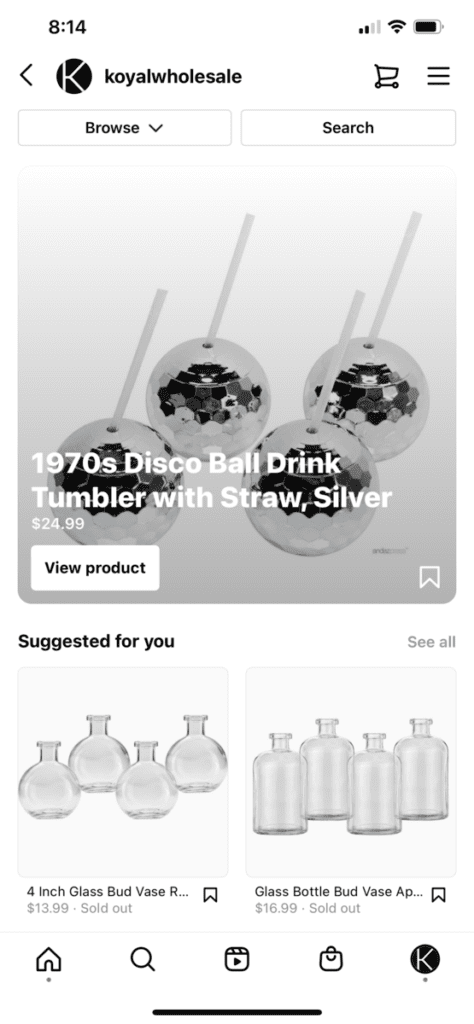
Source: Koyal Wholesale’s Instagram
TikTok
One big advantage to selling through social media channels on Shopify is that it allows you to create a store for TikTok, which isn’t offered by BigCommerce. TikTok has grown exponentially in the last few years and has 1 billion active monthly users as of September 2021. With so many users, the platform has a tremendous amount of reach, with 74% of users saying they looked for more information on a product they saw on TikTok. There are currently more than a million small businesses already using Shopify to sell their products on TikTok.
When you use TikTok to sell you can:
- Tag your products in posts.
- Create a shopping tab that links to your profile, which makes it easy for people to look at products.
- Make your ads blend in with natural content for more engagement.
Once you have decided which social media channels are right for you and link them, make sure to optimize other details like your checkout process to ensure great customer experience and maximize sales.
How Can This Help My Ecommerce Business?
With about 3.4% of online sales coming from social media, ecommerce social media is becoming one of the most important ways of marketing products to consumers. One of the many reasons for this shift is that 72% of people use some type of social media today compared to only 5% in 2005. Knowing all the ways social media can help your business is the first step to making the most of these platforms.
Build Brand Awareness
To build brand awareness, people need to be able to find your website or products. In 2020, social media sales were at about $27 billion, and they are estimated to rise to $36.6 billion in 2021. Having your social media channels linked to your ecommerce store can gain new followers or help customers buy products they want directly through social media. It could also allow for repeat customers because once people follow your social media, they may come back again and again with each campaign for new products. Seeing your brand on multiple social channels can also help people remember it. In 2021, 71% of small businesses plan to increase ecommerce social media.
Ads
Ad spend for social media marketing keeps going up because it works. In 2020, ad spending in the U.S. rose to $40 billion, and it is expected to reach $56 billion by 2022. Promoting your brand and products on social media channels can be very helpful in reaching new customers since 77% of Millennials and Gen Z said they made a purchase because of social media. These generations also prefer to shop on Snapchat, TikTok, and Instagram, which can be a big factor when choosing how to link your social media to your ecommerce products. While ads can be good for growing your brand and follower count, there is such a thing as too much of a good thing. 45% of consumers said they would unfollow a brand because of too many ads.
Increase Followers
By using the features on your social media channels to boost certain posts, you can further increase your followers. The more followers you have, the more sales you can get. There are many factors to gain more followers, such as posting good content that provides information about your products, following and interacting with other accounts, and providing a consistent brand tone and image.
Customer Service
Interacting with customers is a huge plus when it comes to people liking your brand. Social media is a great tool to help customers if they need it without the hassle of them trying to find your brand’s contact information elsewhere. 1 in 3 people would rather go to social media for customer service than email or telephone, and almost 50% of consumers said they were more likely to purchase if brands responded to questions and complaints on their social channels. People are also more likely to recommend the brand to their friends if that brand is active and responsive.
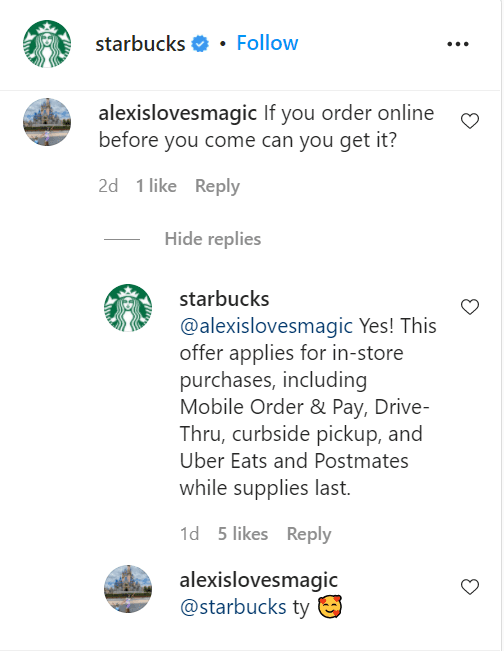
Source: Starbucks Instagram account
User-Generated Content
Content that is made by other social media users about your products can be a major selling point. By encouraging your followers to post content and tag your brand, you can gain more positive reviews and get your product seen by more people. User-generated content also allows you to connect more with your followers by spotlighting their content on your social media channels. 90% of consumers say that they trust user-generated content more than branded content. Word of mouth marketing is becoming an increasingly popular way to help with brand awareness. When people hear about products through word of mouth from their friends and family, they are more likely to buy that product.
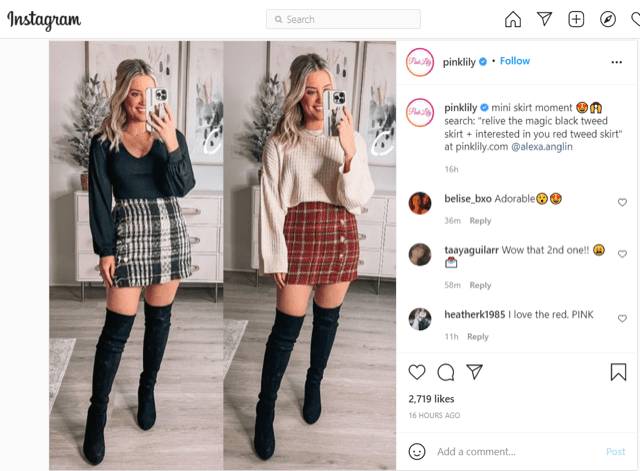
Source: PinkLily Instagram account
Influencer Marketing
Influencer marketing has become an important aspect of ecommerce social media. Using influencers to help promote your brand and get your name out there is a great way to sell more products. Many marketers have found that influencers increase their authenticity in the eyes of followers. 61% of consumers said that they were likely to buy a product that was recommended by an influencer they knew and trusted. 87% of people say that social media helps them figure out what products to buy. With more people becoming influencers, many brands have recognized the value in working with smaller influencers also known as micro-influencers or nano-influencers in addition to influencers with millions of followers. The reason is that micro-influencers with a smaller audience may come across as more authentic. Engagement rates for these types of influencers are usually higher than with influencers who have millions of followers.
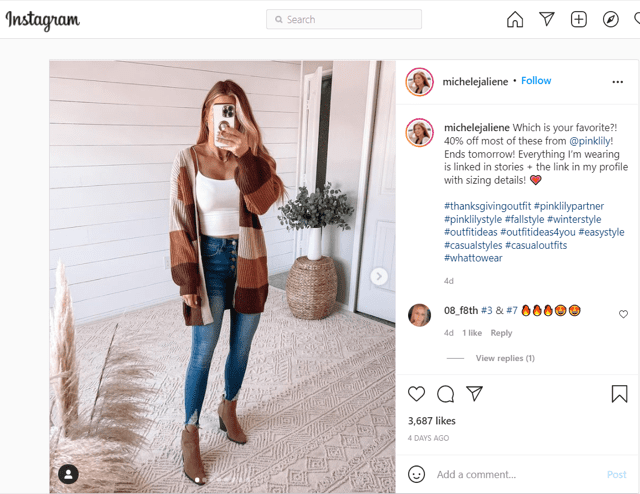
Source: Michele J Instagram account
Partnerships
Influencer marketing is one type of partnership, but another option is to work with a nonprofit or other organization similar to your brand to create a mutually beneficial campaign. Partnering with other companies or brands that have the same values can help you grow, especially if they have a large audience on their social media channels. The more people who see your brand, the more people will find and shop for your products. Partnerships also give you more credibility because people who trust the other organization may find you more trustworthy through your affiliation.
Analytics
Social media analytics offer deeper insights into what your audience and customers are looking for with your products. Knowing your audience is a huge plus with ecommerce social media. By looking at all the information you get from different campaigns, you can consider everything and tailor your products to fit your customer’s needs, which makes them more likely to purchase from you. Checking your social media analytics is one of the best ways to see what content worked and what content you may need to change in the future.
Having your social media channels linked to your ecommerce website can help your brand in a lot of ways. To find out more about social channels or other web design issues, make sure to follow our blog.

